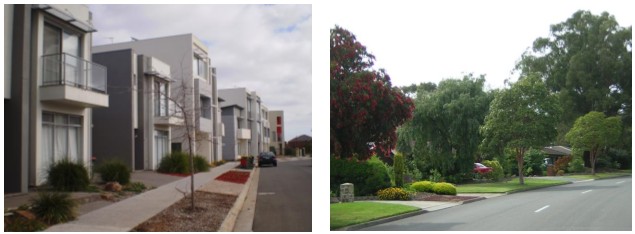Griffith University academics, Tony Matthews and Jason Byrne, have posted an interesting article in The Conversation urging Australia’s planners to develop urban greening strategies to overcome the so-called “heat island effect” and cool Australia’s cities:
…green infrastructure – including street trees, green roofs, vegetated surfaces and green walls – is emerging as a viable way to help cities adapt to increased heat. Uptake of these technologies is slowly increasing in many cities around the world…
The broadening appeal of green infrastructure is helped by the fact it offers multiple benefits.
For example, shading from strategically placed street trees can lower surrounding temperatures by up to 6℃, or up to 20℃ over roads. Green roofs and walls can naturally cool buildings, substantially lowering demand for air conditioning. Green infrastructure can also provide habitat for wildlife, recreational opportunities for people, better management of stormwater runoff and improved urban aesthetics…
Foliage allows local cooling through evapotranspiration, where plants release water vapour into the surrounding atmosphere.
While the ambition to boost green infrastructure is admirable, one wonders how it can be successful amid never-ending immigration and population growth and the corresponding increased urban density, which is seeing backyards and green space disappear in order to accommodate new housing and infrastructure?
It is worth noting that housing developments built in the 1950s, 1960s, 1970s, 1980s and 1990s (represented below on the right) typically have large blocks, ample green space, and lots of tree cover. In short, they are a desirable places to live and do not suffer from the “heat island effect”. Now compare these 20 to 60 year-old developments with the cluttered rubbish produced today (represented below on the left), which are proliferating:

Maybe I am missing something here, but it would seem that increasing green infrastructure in places like Melbourne is not consistent with the projected explosion of the city’s population to 8 million, along with the increased population density?
I am not the only one to notice this contradiction.
Back in January last year, Helen Brown, Lecturer in Health, Safety and Environment at Curtin University, published an article in The Conversation arguing that the lack of trees in new housing developments is significantly increasing the use of air conditioners and energy use:
So why are all the trees removed in so many of our developments?
The population of major Australian cities is expected to double in the next four to five decades. Planned increases in urban density are likely to result in the removal of a significant number of trees from urban areas.
Fewer trees in cities help create urban heat island effects – that’s when buildings and footpaths absorb the sun’s heat and then radiate it back out. Increases of up to three degrees are common and, in extreme cases, night-time increases of up to 12 degrees have been recorded.
Ms Brown was joined by a group of Melbourne and Monash University academics, who produced similar analysis arguing that the loss of vegetation from urban consolidation is causing heat-island effects, in turn raising temperatures and energy use:
Ever-growing houses, on ever-shrinking plots, mean that the average backyard has shrunk. Population growth has driven up property prices so that residential blocks are being subdivided for units or townhouses.
Meanwhile, larger green open spaces are being sold and developed…
An ever-growing population being squeezed into an existing urban footprint means that trees, lawns and other green infrastructure will inevitably make way to buildings and roads. In turn, this will make it increasingly difficult to boost green infrastructure and overcome the heat island effect.

